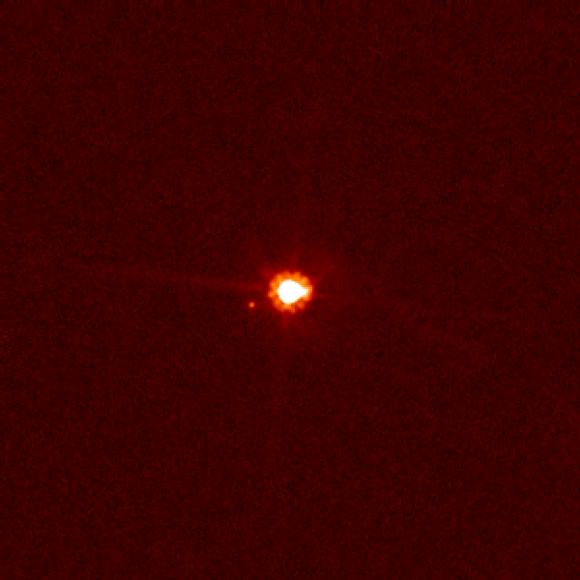
HST image of Pluto and its moons, Charon, Nix and Hydra. Image Credit: NASA, ESA, H. Weaver (JHU/APL), A. Stern (SwRI), and the HST Pluto Companion Search Team
The controversy between Pluto and Eris regarding their status as “largest dwarf planet” continues. During a joint meeting of the American Astronomical Society Division for Planetary Sciences and the European Planetary Science Congress last week in Nantes, France, new data was presented that may help settle the debate. The new findings regarding this size of Eris may be a surprise to some, and to others a confirmation of what was believed to be true.
How were astronomers able to make the new measurements of Eris, and what implications will these new measurements have on the Pluto / Eris debate?
Using a celestial alignment known as an occultation, Bruno Sicardy of the Paris Observatory (University of Pierre and Marie Curie, France) and his team were able calculate the diameter of Eris in 2010. The occultation was caused by Eris moving past a background star, which blocked the star’s light and cast a small shadow on Earth. When Sicardy and his team compared the shadow’s size at two different sites in Chile, the calculations provided a diameter of 2,326 kilometers for Eris. A previous study by Sicardy in 2009 placed Pluto’s diameter to be at least 2,338 kilometers.
However, the first estimates of Eris’ size that were made shortly after its discovery put the diameter at 3,000 km, plus or minus 400 km. But a later estimate from observations with the Hubble Space Telescope said Eris might be 2,400 km in diameter, plus or minus 100 km.
If Sicardy’s data calculations hold true, this places Pluto and Eris at nearly the exact same diameter. What has continued to not be up for debate, however, is that Eris is far more massive than Pluto. Given a nearly identical diameter for Eris and Pluto, Eris’s extra mass makes it the denser of the two dwarf planets. According to Sicardy and his team the increased density of Eris, “indicates that Eris is mainly composed of rocky material, with a relatively thin ice mantle.” Since Pluto’s density indicates it comprised of about equal parts ice and rock, Eris’s extra mass would appear to validate Sicardy’s assertion.

Eris and its moon, Dysnomia. Credit: NASA, ESA, and M. Brown (California Institute of Technology)
The Co-discoverer of Eris, and noted “Plutokiller” Mike Brown (Caltech) offers an interesting thought regarding the Pluto / Eris Debate:
“Scientifically, knowing which one is bigger will teach us…. absolutely nothing. The fact that they are nearly identical in size is scientifically interesting; which one is a few kilometers bigger than the other matters not one bit.” Brown also added, “But, still, I will admit to having a bit of an emotional attachment to Eris, so, deep down inside, I want to believe it will turn out to be a little bigger.
You can read a brief synopsis of Sicardy’s findings at:http://meetingorganizer.copernicus.org/EPSC-DPS2011/EPSC-DPS2011-137-8.pdf
If you’d like to learn more about the Pluto / Eris debate, Brown has some great thoughts regarding the debate on his blog at: http://www.mikebrownsplanets.com/2010/11/how-big-is-pluto-anyway.html
Source: Universe Today
No hay comentarios:
Publicar un comentario